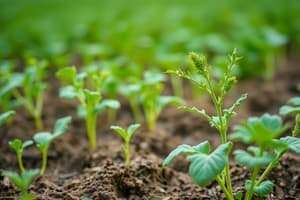Podcast
Questions and Answers
What is the main difference between the reproduction processes of a frog and a bird?
What is the main difference between the reproduction processes of a frog and a bird?
- Frogs undergo metamorphosis, while birds do not. (correct)
- Frogs reproduce sexually, while birds reproduce asexually.
- Frogs have external fertilization, while birds have internal fertilization. (correct)
- Frogs lay eggs in water, while birds lay eggs on land.
Which of these is NOT an example of a natural phenomenon?
Which of these is NOT an example of a natural phenomenon?
- Burning of a candle (correct)
- Weathering of rocks
- Earthquake
- Lightning strike
Which of the following is NOT a characteristic of adolescence?
Which of the following is NOT a characteristic of adolescence?
- Rapid physical growth
- Changes in hormonal levels.
- Emotional maturity (correct)
- Development of secondary sexual characteristics
Which of the following is an example of friction?
Which of the following is an example of friction?
What is the main purpose of the process of crop rotation?
What is the main purpose of the process of crop rotation?
Flashcards
Crop Production
Crop Production
The process of growing plants for food, fiber, or fuel.
Microorganisms
Microorganisms
Tiny living organisms that can be beneficial or harmful.
Coal and Petroleum
Coal and Petroleum
Fossil fuels derived from ancient plants and animals, used for energy.
Reproduction in Animals
Reproduction in Animals
Signup and view all the flashcards
Chemical Effects of Electric Current
Chemical Effects of Electric Current
Signup and view all the flashcards
Study Notes
Crop Production and Management
- Crop production involves cultivating plants for food, fiber, or other uses.
- Key aspects include soil preparation, sowing, irrigation, fertilization, pest and disease control, harvesting, and storage.
- Proper crop management ensures high yields and good quality produce.
- Different crops require different growing conditions.
Microorganisms: Friend and Foe
- Microorganisms are tiny living organisms.
- Some are beneficial (e.g., for food production or aiding digestion) and others are harmful (disease-causing).
- Microorganisms play crucial roles in maintaining ecosystems.
Coal and Petroleum
- Coal and petroleum are fossil fuels formed from ancient organisms.
- They are non-renewable sources of energy.
- Coal is used for electricity generation and in industries.
- Petroleum fuels transportation and is used in various products.
- Burning fossil fuels releases greenhouse gases causing pollution.
Reproduction in Animals
- Reproduction is the process by which organisms create new individuals.
- Animals reproduce sexually through the fusion of gametes (sperm and egg).
- Different animals have various reproductive strategies.
- There are different types of sexual reproductive methods in animals.
Reaching the Age of Adolescence
- Adolescence is the transition period between childhood and adulthood.
- Physical, mental, and emotional changes occur during this time.
- Hormonal changes are key drivers of these developments.
- Societal and cultural influences also shape adolescence.
Force and Pressure
- Force causes a change in an object's motion.
- Pressure is force per unit area.
- Force and pressure have numerous applications in various fields.
- Understanding force and pressure is essential for engineering and design.
Friction
- Friction is the force that opposes motion between surfaces in contact.
- Friction can be helpful or harmful depending on the situation.
- Factors affecting friction include surface roughness and the applied force.
- Friction reduces speed or causes heat.
Sound
- Sound is a form of energy that travels as waves.
- Sound waves need a medium to travel.
- Sound characteristics include volume, pitch, and quality.
- Sound plays a significant role in communication and entertainment.
Chemical Effects of Electric Current
- Electric current can cause chemical reactions.
- Electrolysis is one example of this effect.
- Electrolysis is used for various industrial purposes and in extracting metals.
Some Natural Phenomena
- Natural phenomena include events like earthquakes, hurricanes, and storms.
- These events can have significant impacts on human life.
- Scientists study these phenomena to understand and predict them.
Light
- Light is a form of electromagnetic radiation.
- It travels in straight lines.
- Light has various properties and behaviors, like reflection, refraction, and dispersion.
- It is essential for vision and numerous other applications.
Studying That Suits You
Use AI to generate personalized quizzes and flashcards to suit your learning preferences.




